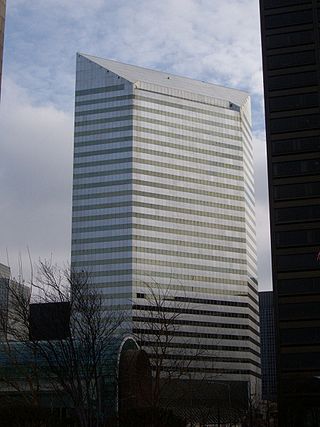
One Cleveland Center is the fifth tallest skyscraper in downtown Cleveland, Ohio. The building has 31 stories, rises to a height of 450.01 feet (137.16 m), and is located at 1375 East 9th Street. It has about 530,014 square feet (49,239.9 m2) of office space. It was purchased on May 15, 2008, for $86.3 million by Optima International LLC, a Miami-based real estate investment firm led by Chaim Schochet and 2/3rd owned by the Privat Group, one of Ukraine's largest business and banking groups.

The Justice Center Complex is a building complex located in the Civic Center District in Cleveland, Ohio, in the United States. The complex consists of the Cleveland Police Headquarters Building, the Cuyahoga County and Cleveland Municipal Courts Tower, and the Correction Center, and Jail II. It occupies a city block bounded by Lakeside Avenue, Ontario Street, West 3rd Street, and St. Clair Avenue. The Lakeside Avenue entrance faces the Cuyahoga County Court House, erected in 1912.

The 9 Cleveland is a residential and commercial complex located in Downtown Cleveland, Ohio, United States, at the corner of East Ninth Street and Euclid Avenue. It includes three buildings, the largest of which is a 29-story, 383 feet (117 m) tower commonly known by its previous name of Ameritrust Tower and formerly known as the Cleveland Trust Tower. The tower was completed in 1971 and is an example of brutalist architecture, the only high-rise building designed by Marcel Breuer and Hamilton Smith. The complex also includes the adjacent Cleveland Trust Company Building, completed in 1908, and the Swetland Building.

Public Square is the central plaza of Downtown Cleveland, Ohio. Based on an 18th-century New England model, it was part of the original 1796 town plat overseen by city founder General Moses Cleaveland of the Connecticut Land Company. The historical center of the city's downtown, it was added to the National Register of Historic Places in 1975.

This is a list of the National Register of Historic Places listings in Cleveland, Ohio.

The Citizens Building is a high-rise office and retail building located at 840 Euclid Avenue in Cleveland, Ohio, in the United States. The structure was built in 1903 by the Citizens Savings and Trust, a local bank. Its entrance portico was removed in 1924, and a two-story addition erected in its place. Home to the City Club of Cleveland since 1982, the building was renamed the City Club Building in 1999.
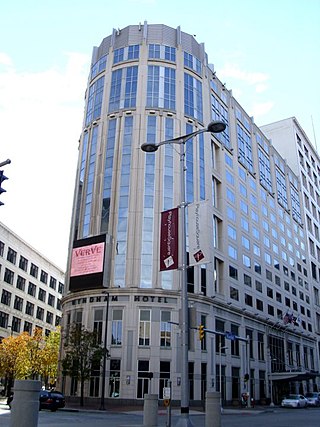
The Crowne Plaza Cleveland at Playhouse Square is a mid-sized, 14-story Crowne Plaza hotel in downtown Cleveland's Playhouse Square district, located at the intersection of Huron Road and Euclid Avenue. Originally known as the Wyndham Cleveland at Playhouse Square, the structure helped to complete the revitalization of Playhouse Square. It changed brand names in August 2017.
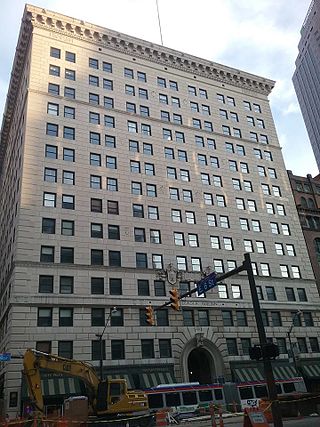
The Leader Building is a 15-story high-rise building located at the southwest corner of Superior Avenue and East 6th Street in Downtown Cleveland, adjacent to the Cleveland Arcade and across the street from the Cleveland Public Library.

The Garfield Building is a high-rise building on the corner of Euclid Avenue and E. 6th Street in Cleveland, Ohio, in the United States. It was the first steel frame skyscraper constructed in the city.

The Cleveland Trust Company Building is a 1907 building designed by George B. Post and located at the intersection of East 9th Street and Euclid Avenue in downtown Cleveland's Nine-Twelve District. The building is a mix of Beaux-Arts, Neoclassical, and Renaissance Revival architectural styles. It features a glass-enclosed rotunda, a tympanum sculpture, and interior murals.
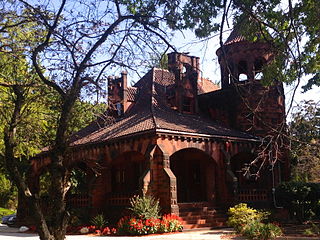
Riverside Cemetery Gatehouse is a historic office building located in Riverside Cemetery at 3607 Pearl Road in Cleveland, Ohio. It was completed in 1897, and added to the National Register of Historic Places in 1987. A significant interior renovation occurred about 1991 to 1992.
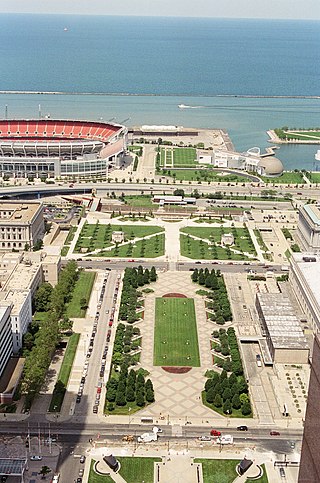
The Cleveland Convention Center was located in downtown Cleveland, Ohio. Built by the city of Cleveland beneath the Cleveland Mall adjacent to Public Auditorium, it was completed in 1964. Plans for the convention center were first made in 1956, but voters twice rejected initiatives to fund construction before approving a bond levy in November 1963. A local private foundation donated several million dollars to beautify the mall atop the convention center with a reflecting pool and fountains.

Bertram Leonard Wolstein, known to his friends as Bart and publicly as Bert L. Wolstein, was an American real estate developer, sports team owner, and philanthropist based in Cleveland, Ohio. He founded Developers Diversified Realty Corporation, which at the time of his death was the 4th-largest developer of shopping centers in the United States. In 1979, he purchased the Cleveland Force Major Indoor Soccer League team, and attempted to purchase the Cleveland Browns in 1998. He retired from active business in 1997, and became one of the most generous donors in the United States in his final years.

The Baker Motor Vehicle Company Building, also known as the Baker Electric Building, is a historic commercial building in Cleveland, Ohio, in the United States. Built in 1910, it was the first showroom of the Baker Electric Motor Car Co., a pioneer in Brass Era electric automobiles. Baker Electric merged with Rauch and Lang in 1914, and the building was sold in 1920. It served as an auto dealership, machine shop, and print shop for the next 86 years. The structure underwent a two-year renovation and historic preservation from 2006 and 2008, and now serves as a startup business incubator.

The Bingham Company Warehouse is a historic warehouse located in Cleveland, Ohio, in the United States. It was designed by the noted local firm of Walker and Weeks for the W. Bingham Company, and is one of the architectural firm's few utilitarian commercial buildings. For many years, W. Bingham Co. was the Midwest's largest hardware manufacturer and wholesaler. The W. Bingham Co. went out of business in 1961, and the warehouse was sold to a succession of owners of the years. The warehouse was sold to private investors in 2001, who converted it into apartments, known today as The Bingham.

The Body Block, also known as the Charles Body Block and as the Old Smith Arcade, is a historic mixed-use building located on the northwest corner of the intersection of Payne Avenue and E. 55th Street in the Goodrich–Kirtland Park neighborhood of Cleveland, Ohio, in the United States. Erected from 1892 to 1893, the Queen Anne style structure was built for Charles Body, owner of a local wallpaper store. It underwent a major renovation from 1994 to 1995, and was added to the National Register of Historic Places on September 18, 1998.

The Brownell School and Annex are three historic former public school buildings located on Sumner Street in Cleveland, Ohio, in the United States. The Queen Anne-style main building was designed by prominent local architect John Eisenmann, and erected from 1884 to 1885. The first annex was designed by noted local architect Frank Seymour Barnum, and completed in 1905. The second annex, also by Barnum, was finished in 1909. Several individuals of local and national importance were educated there or taught school there, and the building served as the first campus of Cuyahoga Community College in 1962. The building was sold to private owners in 1979, and the complex underwent a major renovation from 1983 to 1985.

The Cedar Glen Apartments is a historic apartment building located in the University Circle neighborhood of Cleveland, Ohio, in the United States. Designed by prominent local architect Samuel H. Weis and completed in 1927, the building originally contained luxury apartments and served as a gateway to the more exclusive neighborhood of Cleveland Heights, on whose border the building is located. Threatened with demolition in 1992, the building was purchased by new owners and converted into condominiums.

The Cleveland Foundation Centennial Lake Link Trail, originally known as the Lake Link Trail, is a cycling, hiking, and walking trail located in the city of Cleveland, Ohio, in the United States. Owned by the city of Cleveland and maintained by Cleveland Metroparks, the trail runs along the former track bed of the Cleveland and Mahoning Valley Railroad. The trail is named for The Cleveland Foundation, a local community foundation which donated $5 million toward the trail's construction. The southern leg of the 1.3-mile (2.1 km) trail opened in August 2015, and the northern leg in August 2017. The middle leg will begin construction once the Irishtown Bend hillside is stabilized. A bridge connecting the trail to Whiskey Island will begin construction in Spring 2019 and will be completed in early Summer 2020.

The Halle Building, formerly known as the Pope Building and after 2014 as The Residences at Halle, is an 11-story Chicago School mixed-use structure located in the Downtown Cleveland central business district in Cleveland, Ohio, in the United States. Designed by architect Henry Bacon, the building was the flagship department store of the Halle Brothers Co. from 1910 to 1982.

























